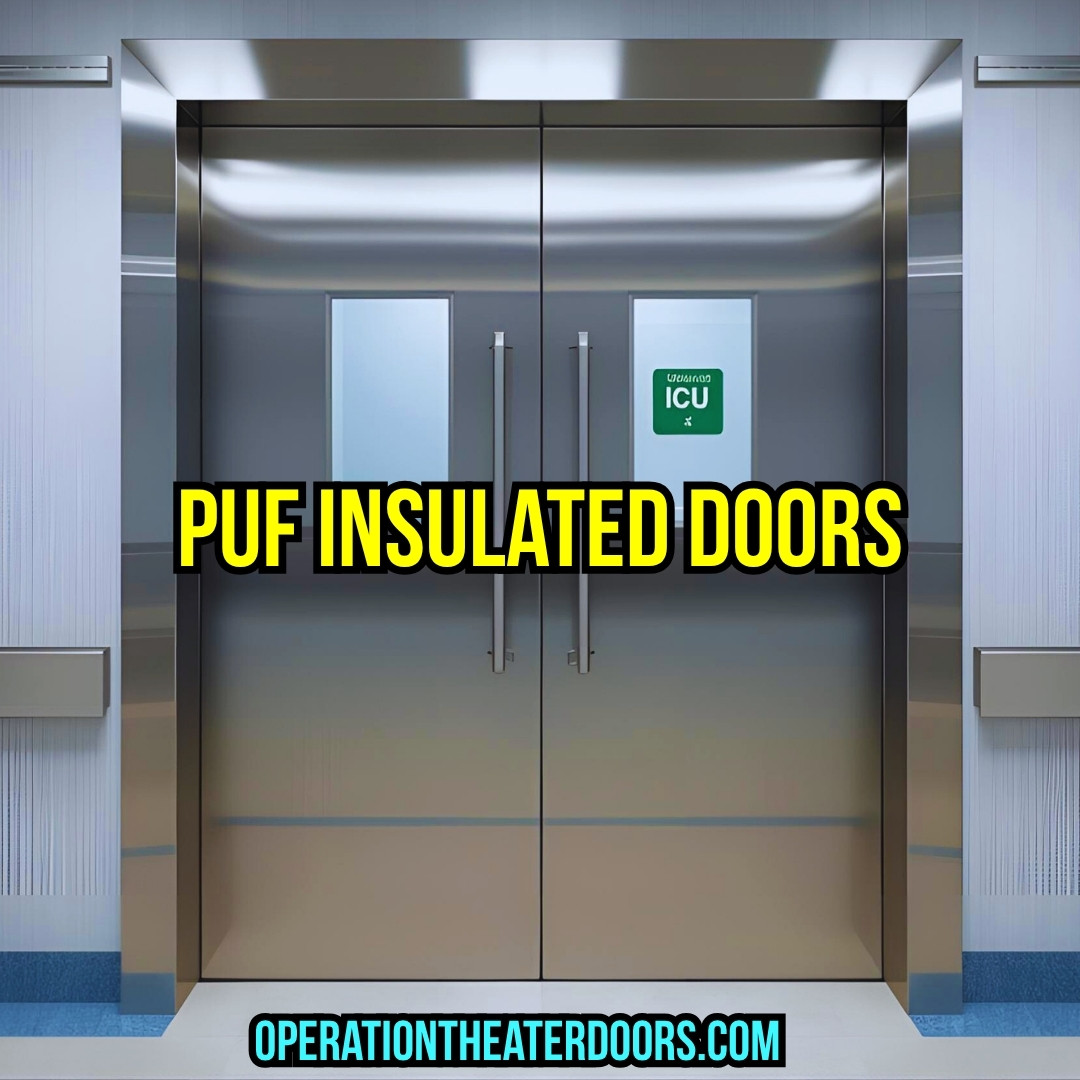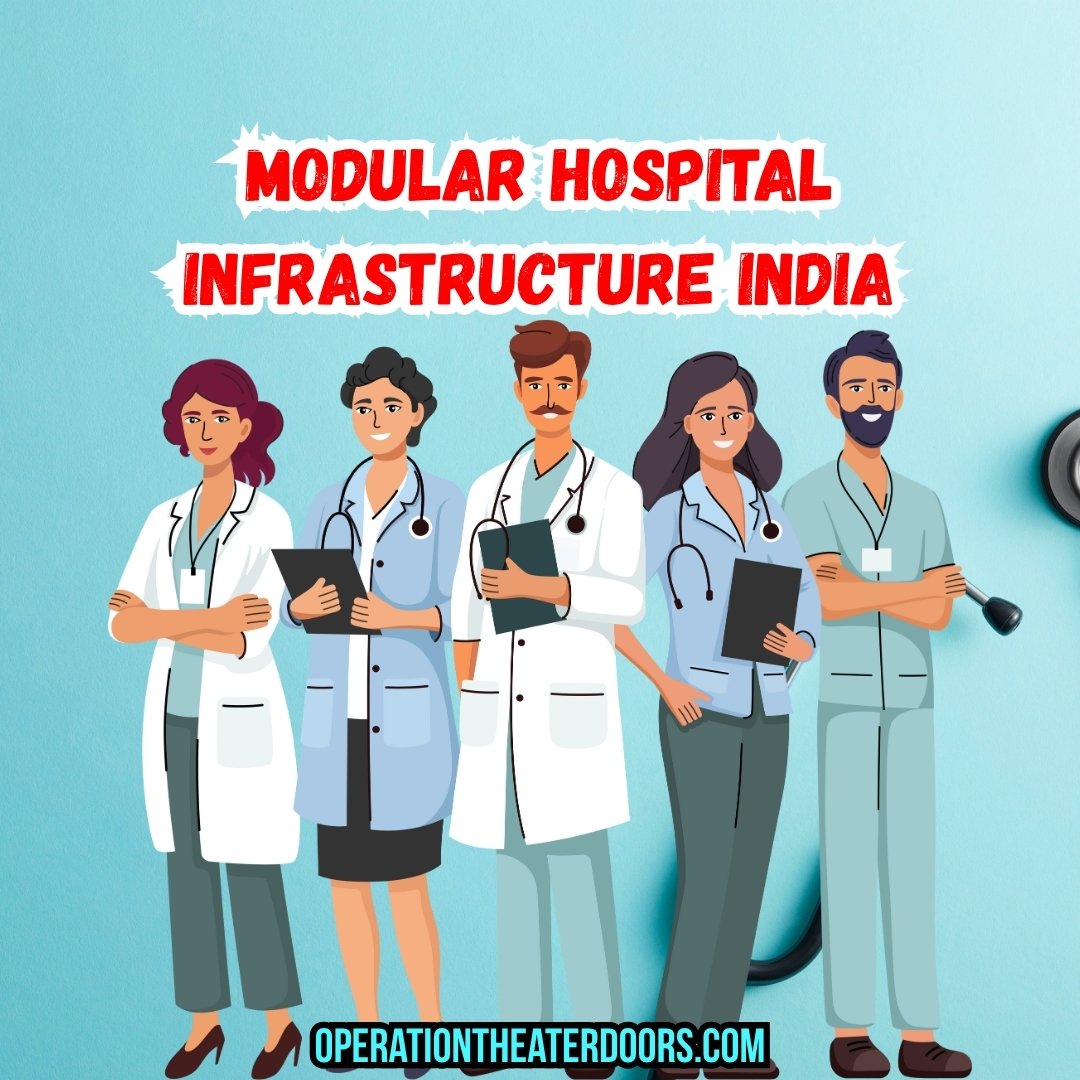
When it comes to hospitals, pharmaceutical cleanrooms, and modular healthcare facilities, every single component plays a role in ensuring patient safety and infection control. Among these, hospital doors are often overlooked yet they are one of the most critical elements in creating a safe and hygienic environment. Whether it is an ICU door, an operation theatre door, or a cleanroom flush door, the right choice directly impacts hygiene, staff movement, regulatory compliance, and overall infrastructure efficiency.
In cities like Ahmedabad, Gujarat, where hospital projects, pharma cleanrooms, and modular setups are rapidly growing, the demand for PUF insulated doors, hermetical OT doors, and customized ICU doors is on the rise. From NABH guidelines for infection control to WHO standards for cleanroom environments, doors are no longer just entry points—they are engineering solutions that support hygiene, safety, and compliance.
This article takes a detailed look at how different types of hospital doors—ICU doors, OT doors, cleanroom doors, fire exit doors, and PUF insulated doors—improve hygiene and safety while supporting the growing needs of modern healthcare infrastructure.
ICU Doors: Enhancing Patient Safety and Infection Control
The ICU (Intensive Care Unit) is the most sensitive area of any hospital. Patients in critical care require a completely controlled environment where even small lapses in hygiene can be life-threatening. This is where ICU doors play a key role.
A high-quality ICU door is designed to:
- Prevent cross-contamination by minimizing air leakage.
- Support smooth and silent movement for quick emergency access.
- Ensure visibility through flush glass panels, without compromising on hygiene.
- Integrate with hospital automation systems for touchless operation.
In India, many ICU setups now prefer hermetically sealed ICU doors that provide airtight closure, preventing airborne bacteria from entering. For example, an ICU door manufacturer in Ahmedabad designs doors with anti-microbial coatings, easy-to-clean flush surfaces, and durable hardware that comply with NABH recommendations.
Hospitals and contractors working on ICU setup projects often integrate such doors with positive pressure systems and HEPA filtration, making them a vital part of infection prevention.
(Reference: ICU Doors)
(External Reference: NABH Guidelines)
Operation Theatre Doors: Supporting Sterility in Surgical Environments
The operation theatre (OT) is a zero-compromise zone when it comes to sterility. Every material, every corner, and every surface must be easy to disinfect and resistant to microbial growth. The operation theatre door is the first barrier between the sterile OT and the outside environment.
Key features of modern OT doors include:
- Hermetical sealing to ensure air-tightness.
- PUF insulated cores for thermal and sound control.
- Radiation shielding options for X-ray and cath labs.
- Automatic sliding functions for hands-free access.
A high-quality operation theatre door manufacturer ensures compliance with WHO’s infection prevention standards while also aligning with NABH accreditation norms. For hospitals in Gujarat, modular OT projects demand doors that integrate with laminar airflow systems and support proper air circulation.
This is why contractors often opt for hermetical OT doors that reduce air infiltration, helping maintain sterility and positive pressure inside the OT.
(Reference: Operation Theatre Doors)
(External Reference: WHO Infection Prevention)
Fire Exit Doors: Safety Beyond Hygiene
While hygiene and infection control are critical, hospitals also need to meet fire and emergency safety standards. A fire exit door ensures that in the event of an emergency, staff, patients, and visitors can evacuate quickly and safely.
High-quality emergency exit doors for hospitals are designed with:
- Fire resistance up to 120 minutes.
- Easy push-bar exit systems for panic situations.
- Anti-corrosive finishes for long-term durability.
- Compliance with Indian fire safety codes.
For hospital infrastructure planners in Ahmedabad, integrating fire exit doors into ICU and OT setups is both a regulatory requirement and a life-saving necessity. Unlike standard wooden or metal doors, modern steel fire-rated doors offer insulation, smoke control, and reliability in emergencies.
(Reference: Fire Exit Doors)
(External Reference: Ministry of Health – Safety Standards)
Cleanroom Doors: Ensuring Contamination-Free Environments
Cleanrooms are not limited to pharma manufacturing—they are equally vital for IVF centres, diagnostic labs, and modular OTs. A cleanroom door is the most crucial component in maintaining the ISO Class 5–8 cleanroom environment.
Specialized cleanroom flush doors are designed with:
- Antimicrobial powder coating for infection control.
- Flush-mounted hardware to reduce particle accumulation.
- Air-tight sealing to maintain positive/negative pressure differentials.
- Compatibility with air showers and pass-through systems.
For pharma QA/QC teams, cleanroom doors in Ahmedabad are critical in achieving GMP compliance. Hospitals and labs also prefer cleanroom doors with PUF or honeycomb cores, making them lightweight yet durable.
(Reference: Cleanroom Doors)
(External Reference: WHO GMP Standards)
PUF Insulated Doors & Panels: Energy Efficiency Meets Hygiene
The use of PUF insulated doors and PUF panels has grown rapidly across modular OTs, ICUs, and cleanroom projects. Polyurethane Foam (PUF) provides excellent insulation while being lightweight, durable, and resistant to microbial growth.
Advantages of PUF insulated doors include:
- High thermal insulation, reducing energy costs.
- Resistance to moisture and bacterial contamination.
- Lightweight yet structurally strong construction.
- Smooth, flush finish for easy cleaning.
In Gujarat’s hospital infrastructure industry, PUF doors and panels are widely used in turnkey projects where modularity and quick installation are priorities. A reputed manufacturer of PUF panel doors ensures NABH and GMP compliance while delivering doors that blend performance with affordability.
(Reference: PUF Insulated Doors)
(External Reference: Bureau of Energy Efficiency)
Materials & Durability: Choosing the Right Hospital Door
The choice of material defines both hygiene and durability in hospital doors.
Common materials include:
- Galvanized Steel with Powder Coating – durable, rust-resistant, and hygienic.
- Aluminium Frames with Flush Panels – lightweight and corrosion-free.
- PUF Panels – best for insulation and modular construction.
- Stainless Steel – widely used in cleanrooms and OT scrub areas.
In Indian hospitals, wooden doors are being phased out due to hygiene risks. Instead, modern hospital doors in Ahmedabad rely on engineered steel or PUF panels that provide long-term durability and meet NABH standards.
(Reference: Turnkey Projects)
(External Reference: Central Pollution Control Board – Hospital Guidelines)
Safety, Compliance & Infection Control
A hospital door is not just a physical barrier—it is a compliance component. Whether it is an ICU, OT, cleanroom, or pharma unit, the right door ensures compliance with:
- NABH Accreditation for hospitals.
- WHO GMP Standards for pharma and cleanrooms.
- Fire Safety Codes under NBC India.
- Energy Efficiency norms under BEE.
For example, a hermetical OT door manufacturer in Ahmedabad ensures that all products are designed to minimize microbial contamination while meeting international infection prevention standards. Hospitals planning for ICU setup in Gujarat often consult with NABH consultants to ensure door specifications are aligned with compliance norms.
(Reference: ICU Setup)
(External Reference: National Building Code India)
Customization & Modular Setups
No two hospitals or cleanrooms are the same. That is why modern hospital doors are fully customizable. From size and material to insulation and automation, customization ensures that each project meets specific needs.
In modular operation theatres, doors are integrated into wall panels to create seamless, flush surfaces. Automated sliding doors, hermetical sealing, and customized vision panels are some of the features preferred by NABH consultants.
Turnkey project companies in Ahmedabad and Gujarat are increasingly adopting custom cleanroom solutions where doors, wall panels, and HVAC systems are designed as one integrated unit. This ensures faster project execution and full regulatory compliance.
The healthcare industry in Ahmedabad and Gujarat is rapidly evolving, with large multispeciality hospitals, pharma manufacturing hubs, IVF centres, and diagnostic labs investing in modular facilities.
Some notable local trends include:
- ICU Door Manufacturers in Ahmedabad providing NABH-compliant products for multispeciality hospitals.
- OT Door Manufacturers in Gujarat working with modular OT contractors.
- Cleanroom solutions providers catering to pharma units in Vatva, Sanand, and Ankleshwar.
- PUF insulated door suppliers supporting turnkey healthcare projects in Gandhinagar and Vadodara.
For hospitals in Gujarat, choosing the right door is not just about durability—it is about ensuring patient safety, regulatory compliance, and long-term operational efficiency.
(Reference: Cleanroom Solutions)
FAQs
Q1. What makes a hospital door NABH compliant?
A hospital door is NABH compliant when it has smooth, flush surfaces, antimicrobial coatings, hermetical sealing where needed, and supports proper infection control.
Q2. Which material is best for ICU doors in India?
Galvanized steel with powder coating and PUF cores are considered best for ICU doors as they are durable, hygienic, and resistant to microbial growth.
Q3. What is the difference between cleanroom doors and hospital doors?
Cleanroom doors are designed for particle control, air-tightness, and ISO class compliance, while hospital doors focus more on hygiene, durability, and patient safety.
Q4. How do PUF insulated doors improve infection control?
PUF insulated doors have smooth, non-porous surfaces that prevent bacterial growth, and their insulation helps maintain stable environmental conditions in ICUs and OTs.
Q5. Why are hermetical doors preferred in modular OTs?
Hermetical OT doors prevent air leakage, maintain sterility, and ensure positive pressure, making them the standard for NABH-compliant modular OTs.
Q6. Can fire exit doors also be hygienic?
Yes. Modern fire exit doors in hospitals are made of galvanized steel with antimicrobial coatings, offering both fire safety and hygiene.
Q7. Are cleanroom flush doors necessary for IVF centres?
Yes. IVF labs require particle-free, contamination-controlled environments, making cleanroom flush doors a necessity for compliance and safety.
Q8. Do hospital doors affect HVAC efficiency?
Absolutely. Hermetical and PUF insulated doors reduce air leakage, helping HVAC systems maintain temperature, pressure, and cleanliness more efficiently.
Q9. What is the role of turnkey solutions in hospital door installation?
Turnkey healthcare solution providers integrate doors, panels, HVAC, and compliance into one project, ensuring faster execution and regulatory approval.
Q10. How can hospitals in Gujarat source compliant doors?
They can work with specialized manufacturers in Ahmedabad who provide NABH/WHO compliant ICU, OT, and cleanroom doors with full project support.
Final Thoughts
Hospital doors are no longer simple partitions—they are engineered solutions for hygiene, safety, and compliance. From ICU doors to operation theatre doors, fire exit doors, and PUF insulated doors, each type plays a vital role in creating safe, efficient, and compliant healthcare facilities.
For hospitals, pharma units, and cleanroom projects in Ahmedabad and Gujarat, investing in the right doors is a step towards better patient safety, regulatory compliance, and operational efficiency.
If you are planning an ICU setup, modular OT, or cleanroom project, it is critical to choose a trusted partner who understands compliance, engineering, and turnkey execution. AUM Industries is one such partner, delivering end-to-end solutions for doors, cleanrooms, and hospital infrastructure.






